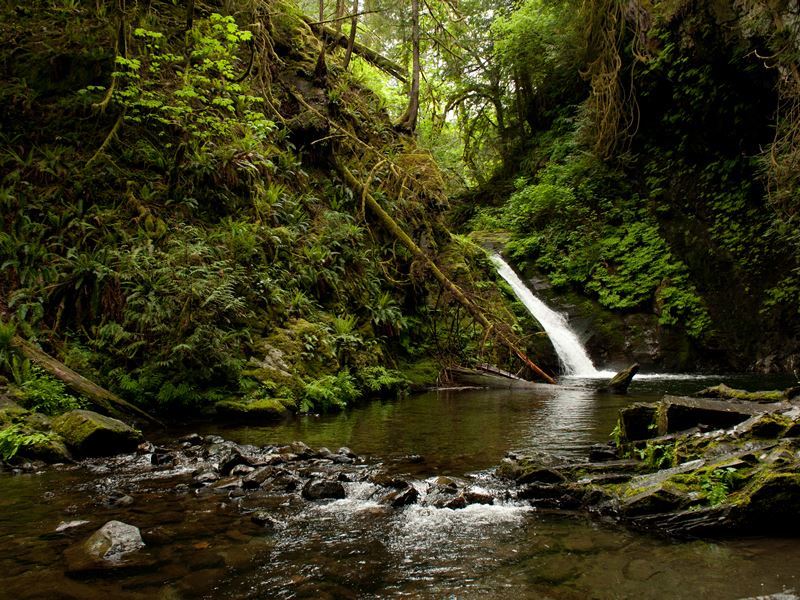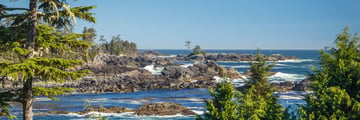Top 10 parks in Vancouver Island
Read time: 7 mins
Fewer places in North America roll out the green carpet quite like Vancouver Island - the giant outdoorsy playground off the coast of mainland British Columbia. We visit the region’s most crowd-pleasing parks - all of which deliver a unique connection with nature.

#10
Goldstream Provincial Park
Where: On southern Vancouver Island, northwest of Victoria.
What: Only a 20-minute drive from the city, this heavily forested playground packs plenty into its 937 acres: old-growth trees (including 600-year-old Douglas Firs, Maples, Garry Oaks, and Arbutus), Insta-worthy waterfalls, incredible wildlife, a meandering river that meets the sea, and rushing streams loaded with fish (salmon famously come here to spawn in October and November). You’ll also find hiking and walking trails for all skill levels (including the ambitious trek up 419-metre-high Mount Finlayson), an observation deck for spotting bald eagles during the winter, an abandoned gold mine, and a visitor centre that opens daily from 9am to 4:30pm.
The best bits: Almost as tall as its far more glamorous Ontario namesake, the 47.5-metre-high Niagara Falls takes centre stage for its waters that cascade down a rock cliff to a crystal-clear canyon pool below. Equally striking is the Goldstream Falls - a much smaller waterfall located in the southwest corner of the park that’s accessed either by the 30-minute Upper Goldstream Trail or by the short trail near campsite #60 off Sooke Lake Road and Golden Gate Road.

#9
Ruckle Provincial Park
Where: On Salt Spring Island, southeast of Fulford Harbour.
What: Nothing prepares you for the awesomeness of this 1307-acre park in the southern Gulf Islands. Complete with a ragged shoreline, arbutus forest, and cross-crossed hiking trails, the outdoorsy thrills come fast and furious; think birdwatching, swimming, ocean kayaking, fishing, windsurfing, dog walking, beachcombing, scuba diving, and offshore wildlife-watching (sea lions, otters, porpoises, and the odd killer whale if you’re very lucky). There’s also an exciting camping scene that includes 78 walk-in campsites, eight drive-in spaces, ample RV parking, and gorgeously grassy meadows overlooking the Swanson Channel where you can pitch your tent.
The best bits: Whilst off-limits to visitors except on Ruckle Heritage Farm Day (usually held in May), the 200-acre heritage sheep farm on the southern tip of Salt Spring Island is the park’s raison d'être. Irish emigrant Henry Ruckle moved here in 1872 and his family have farmed the historic site ever since. The Ruckle family donated their land to BC Parks in 1972 for the creation of the provincial park, although they still operate the farm and maintain several residences.

#8
Newcastle Island Marine Provincial Park
Where: On Newcastle Island, a few hundred metres offshore from Vancouver Island.
What: A ten-minute ferry hop from Maffeo-Sutton Park, this 1,000-acre site has been luring Vancouver Island folk since 1931 when the Canadian Pacific Steamship Company purchased the land for its pleasure resort (the former dance pavilion is now the visitor centre). Nowadays, this hiking heaven draws have-a-go walkers to its 11 miles of trails - many of which reveal ravishing views across the Strait of Georgia as well as providing access to the island’s historical sites (there’s at least two Salish First Nations villages dating back several thousand years). There’s also camping, cycling trails, and summer swimming at Kanaka or Midden Bay.
The best bits: The 90-minute walking tour begins at the totem pole. Here you’ll be met by a Snuneymuxw guide and given the low-down on the Snuneymuxw people’s First Nations history and their uses for Newcastle Island. There’s also traditional storytelling as well as a gentle nature walk to learn about ancient medicines that the Snuneymuxw people still use to this day. Tours run on Fridays in August at 10:45am and 1:45pm, and on selected dates throughout the year.

#7
Cape Scott Provincial Park
Where: Just off Port Hardy, at the northwestern tip of Vancouver Island.
What: Located at Vancouver Island’s extreme northwestern tip, this 55,100-acre stretch of stormy ocean frontage was named after the lighthouse built here in the 1960’s (it’s still in operation, and one of the very few that hasn’t been automated). Perfect for those seeking a wild and solitary coastal adventure, you can expect a slew of white-sand beaches (San Josef Bay, Guise Bay, Experiment Bight, Lowrie Bay, Nissen Bight, and Nels Bight) as well as three key hiking trails: San Josef Bay Trail (an easy 30 minutes), Cape Scott Trail (a slightly tougher five to six hours), and North Coast Trail (a tricky and testing four to seven days).
The best bits: For a fun-filled night in the wilderness, campsites running on a first-come-first-served basis can be found at the 110-acre Eric Lake as well as at various locations along the North Coast Trail (Shushartie Bay, Skinner Creek, Nahwitti River, Shuttleworth Bight and Laura Creek). Alternatively, follow the backpackers to the mile-long sandy beach at Raft Cove Provincial Park, located just south of San Josef Bay.

#6
Tribune Bay Provincial Park
Where: In Hornby Island, near Vancouver Island's Comox Valley.
What: Just two ferry rides and the best part of a day gets you from Vancouver Island to Hornby - the Salish Sea island that has a geography all of its own (it’s nicknamed the Hawaii of the North). Here you’ll find Tribune Bay Provincial Park - a 237-acre paradise that’s all gleaming white beaches, warm aquamarine swimming waters, dramatic cliffs, gorgeous meadows, and tropical temperatures during the summer. There’s also dazzling displays of wildflowers cloaking the hillsides, unusual sandstone formations along the shoreline, and a good selection of leisurely kayak and boat trips for wildlife-lovers keen to spot eagles, seals, sea lions, and whales.
The best bits: A five-minute stroll from the fabled sands at Tribune Bay leads you to the heart of Hornby Island - an eclectic and progressive-minded refuge for artists and bohemians. Must-dos include browsing the galleries and artists’ studios, shopping for local crafts and produce at the Hornby Island Farmer’s Market, and seeking out all sorts of junk at the recycling depot on Central Road (opened in 1978, this is one of North America's first such environmental initiatives).

#5
Rathtrevor Beach Provincial Park
Where: South of Parkville, on central Vancouver Island.
What: It’s all family-friendly fun at this 857-acre park named after gold prospector William Rath who settled here in 1886 (after his death in 1903, his wife operated the land as a campground, adding the word ‘trevor’ for lyrical effect). There’s old-growth trees, walk-in campsites, trailed woodland, and a large space for afternoon picnics. But it’s the three-mile-long sandy beach that gets all the glory, not least because it’s backed by safe swimming waters (at low tide, it stretches nearly a kilometre out into the Strait of Georgia). The park is also a near-perfect birdwatching spot, particularly in the spring when seabirds congregate for the annual herring spawn.
The best bits: Open daily during the summer (usually July and August), the Rathtrevor Beach Nature House is a must for travellers with kids in tow. More than just an interpretive centre, this nature hub promotes environmental education though camps, special events (movies, bingo, games, quizzes, guest speakers), and the ever-popular Jerry's Rangers program that helps kids to appreciate the nature of the park and respect the planet at large.

#4
Juan de Fuca Provincial Park
Where: West of southern Vancouver Island, between Jordan River and Port Renfrew.
What: Around 72 miles west of Victoria, this 30-mile-long stretch of coastline is a monumental coastal playground that offers hikers the chance to leg it around the West Coast Trail - but in smaller bites. Highlights include the Juan de Fuca Marine Trail that covers 29 miles of the rugged Pacific shoreline, viewpoints such as the Loss Creek and Minute Creek suspension bridges, and dozens of tidal pools filled with interesting marine life. Further thrills include spotting orcas and grey whales as they swim offshore from French Beach, China Beach, and Botanical Beach (the best viewing time is during their annual migration in March and April when they’re off to Alaska).
The best bits: The park’s biologically significant Botanical Beach rewards with unique tide pools, shoreline trails with fantastic geological features, and a reliably good mix of red, purple and orange starfish, sea urchins, white gooseneck barnacles, and blue mussels. There’s a strict look-don’t-touch policy here; even skimming the tide pool waters with sunscreen on your hands can create an “oil slick” that could kill the vulnerable creatures in this sensitive ecosystem.

#3
Strathcona Provincial Park
Where: Spanning practically the entire width of Vancouver Island.
What: The triangular-shaped Strathcona Provincial Park may be staggeringly huge at 607,385-acres, but it seals the deal for nature lovers who want to while away the hours gazing at a landscape laced with alpine meadows, waterfalls, and glacial lakes. Given the park extends from sea level to above 1,800 metres in elevation, the flora and fauna is off-the-scale stunning - especially in the summer months when you’ll see brilliant displays of heather, lupine, monkey flowers, violets, Indian paintbrush, phlox, and moss campion. There’s also plenty here for active types, including arduous hiking trails, canoeing, windsurfing, and rock climbing.
The best bits: It’s a gruelling backcountry hike to Della Falls, but worth it to see what is arguably the highest waterfall in Canada (around eight times higher than Niagara Falls and among the top 10 highest falls in the world with a near-vertical drop of 440 metres). Located in the southern section of the park, this series of three cascades is fed by the waters of Della Lake, which is in turn mostly fed by snow melt and a few small glacial remnants on the nearby peaks.

#2
Broughton Archipelago Marine Provincial Park
Where: At the mouth of Knight Inlet, on the west side of Queen Charlotte Strait.
What: As British Columbia’s largest marine park, this otherworldly wilderness area is a series of small islands set between Northern Vancouver Island and the mainland near the town of Port McNeill, at the southern end of Queen Charlotte Strait, and near tidal-charged Johnston Strait. For wildlife-watchers it doesn’t get better; expect eagles, blue herons, minks, otters, seals, sea lions, porpoises, dolphins, orcas, humpback whales, and even grizzly and black bears. There’s also ancient white-shell beaches and some interesting First Nations sites - most famously the village site of Mamalilaculla which was used for around 10,000 years prior to western settlement.
The best bits: The protected waters and myriad of islands and islets make Broughton Archipelago Marine Provincial Park an excellent kayaking location. Most independent paddlers launch at Telegraph Cove or Alder Bay, but you can also reach the park by water taxi. Just be aware that winds can pick up quickly in this area (as can rough water), and the park is not accessible during certain tides and weather conditions.

#1
Pacific Rim National Park
Where: On Vancouver Island’s wild west coast.
What: As the gateway to Vancouver Island’s rugged west coast, this three-part park (Long Beach, the Broken Group Islands, and the West Coast Trail) really does offer a little bit of everything: old-growth forests, stunning beaches, rocky shorelines, miniature tidal pools, inland waterways, and miles of hike-worthy terrain. There’s also a 34,800-acre chunk of beach-fronted coastal temperate rain forest, a protected area of the Clayoquot Sound UNESCO World Biosphere Reserve, and an interpretive centre for learning about First Nation culture (the coastal landscapes still remain integral to the livelihood of the Nuu-chah-nulth people).
The best bits: The only portion of the park that can be explored by car, Long Beach is a 10-mile stretch of uninterrupted white sand set against a sumptuous backdrop of mountains and lush coastal temperate rain forest between Tofino and Ucluelet. Unsurprisingly, Western Canada’s most iconic beach draws huge crowds (surfers, swimmers, sandcastle builders, walkers, wakeboarders), but given its length you’re hardly likely to be sunbathing elbow-to-elbow.

More Inspiration
Recommended holidays












